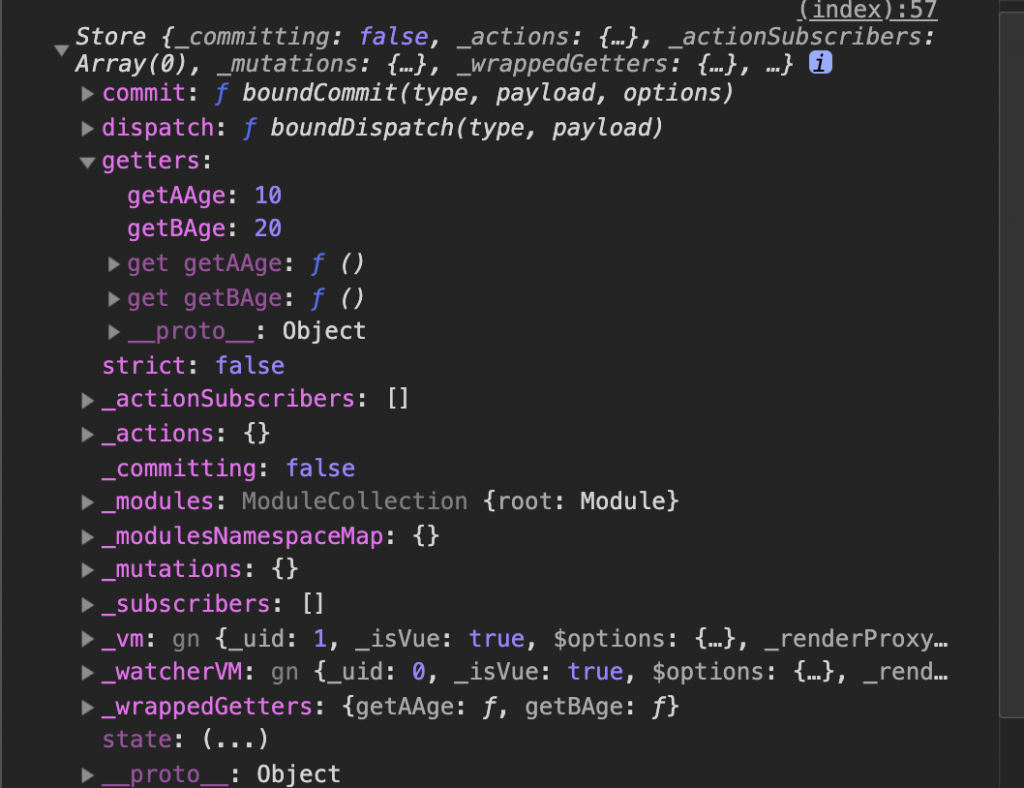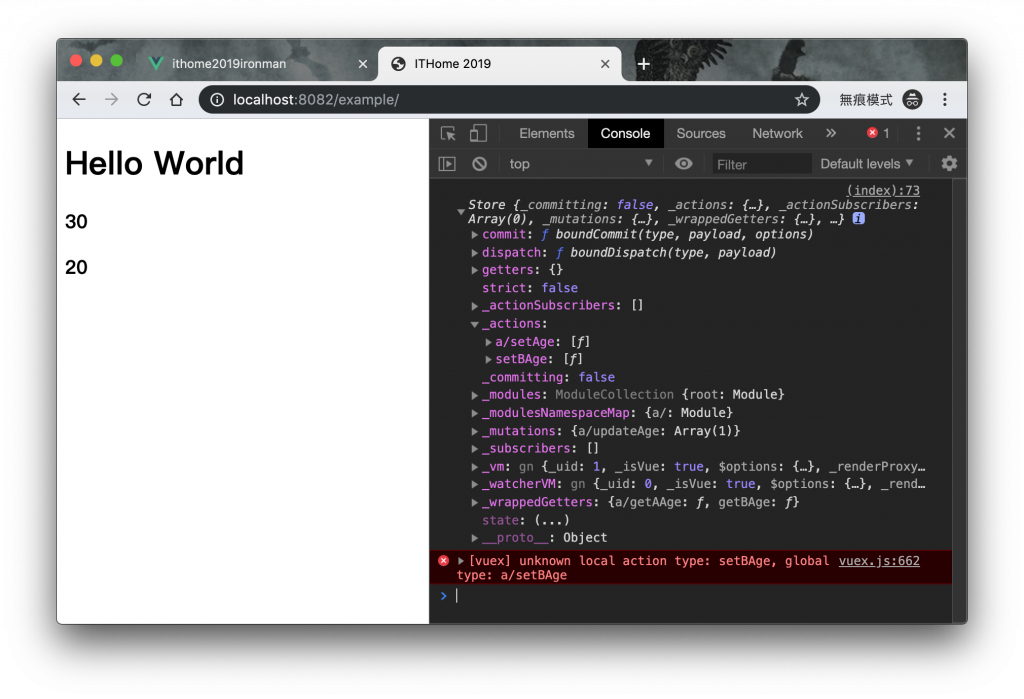部落格同步刊登 [IT 鐵人賽] Vuex 基本入門 Day 8
在我們要聊元件溝通之前,我們先來聊一下關於 Vuex 這個套件。他是官方推出的狀態管理的工具,官方中文翻譯叫做倉庫(?),也是啦,如果把 store 直接翻譯的話,好像叫倉庫也是挺合理的。
但我覺得好像狀態管理會比較符合事實。
如果你是使用 Vue CLI 的話,那就是用 yarn 或 npm 裝一下就好,
yarn add vuex
# OR
npm i vuex
然後在你的 App 裡面,你會有幾件事情要做:
Vue.use(Vuex)。import Vue from 'vue'
import Vuex from 'vuex'
Vue.use(Vuex)
let store = new Vuex.Store({
modules: {
// 這邊就放你要的 Modules
}
})
export default store
我們先回過頭來講講 Vuex 的基本應用。
Vuex 在這邊所擔任的角色,是屬於共享狀態管理機制( Shared State Management ),主要的目的是讓你在各種不同的元件中溝通。溝通是個簡單的說法,主要的目的還是用於共享某些資訊,用以達到資訊同步的目的。
當然,這個並不是訊息溝通的必要手段。官方也說,如果不是大型結構的話,你可以自己製作一個狀態儲存機制,並不一定要使用 Vuex,畢竟這過於冗餘。
那麼這個狀態管理機制裡面有什麼東西呢?
有了這寫核心結構概念後,我們來看看新增一個 Vuex 會有哪些屬性可以使用:
const store = new Vuex.Store({
state: {
age: 18
},
mutations: {
incrementAge: function (state) {
state.age++
}
},
actions: {
ohMyAge: function (commit) {
commit('incrementAge')
}
},
getters: {
getAge: function (state) {
return state.age
}
}
});
這是一個簡單的 Store 實例,如果在元件當中,你會有幾個方法,可以從 Vuex 裡面提出來使用。
import { mapState, mapMutations, mapActions, mapGetters } from 'vuex'
相對應的關係是這樣:
mapState 可以取得 state 裡面的資料。mapMutations 可以取得 mutations 裡面的方法。mapActions 可以取得 actions 裡面的方法。mapGetters 可以取得 getters 裡面的方法。所以說,你們可能會看到這種寫法,
import { mapGetters, mapState } from 'vuex'
export default {
name: 'MyComponent',
computed: {
...mapGetters([
'getAge'
]),
...mapState([
'age'
])
}
}
這麼你會在 template 當中可以直接使用 {{ getAge }},或是你在你的元件裡面,可以使用 this.getAge 來取得資料。
而如果是 mapActions 或是 mapMutations 則是放在 methods 裡面,
import { mapMutations, mapActions } from 'vuex'
export default {
name: 'MyComponent',
methods: {
...mapActions([
'ohMyAge'
]),
...mapMutations([
'incrementAge'
])
}
}
這樣你應該知道這些東西相對應在元件或是 App 裡面可以怎麼使用了。接著,Vuex 還有一些其他的設定:
strict: true 啟用嚴謹模式,當你開啟後,你只能透過 Mutations 來改 state 的數值,如果直接更改你的 state 數值,會被警告。最後,剛剛所提到的 Modules 這個設計,倘若你的結構相當大,那麼為了區分不同的區塊,你可以使用 modules 來區隔,
const hello = {
state: {
// 狀態資料
},
mutations: {
// 操作方法
}
}
const kitty = {
state: {
// 狀態資料
},
mutations: {
// 操作方法
}
}
const store = new Vuex.Store({
modules: {
hello: hello,
kitty: kitty
}
});
這樣你的 Vuex 在元件當中,就利用 store.state.hello 來取得 hello 的 Module 當中的資要。
new Vue({
computed: {
getHello: function () {
return store.state.hello
},
getKitty: function () {
return store.state.kitty
}
}
}).$mount('#app')
這裡還有另外一個設定,叫做 namespaced。一般來說,無論是你是否使用 Modules,裡面的元件在沒有設定 namespaced: true 的情況下,mutations, actions, commit, dispatch 與 getters,大家都是綁訂在 全域 的料結構內,所以,如果依照剛剛的例子來看:

你會看到在 getters 裡面有兩個東西,一個叫做 getAAge 另一個叫做 getBAge,如果我們把 getAAge 這個 Module 加上 namespaced: true 之後,他就會變成這樣:

所以說,這樣我們再使用 Getters 的時候,寫法就會略有差異:
import { mapGetters } from 'vuex'
export default {
name: 'MyComponent',
computed: {
...mapGetters({
getAAge: 'a/getAAge',
getBAge: 'getBAge'
})
}
}
這些情況,在 mapActions, mapMutations 與 mapGetters 上面都適用。而,如果你的 Module 底下還有 Module,且也開啟 namespaced: true 的話,那就可能會有這種結構出現:
import { mapGetters } from 'vuex'
export default {
name: 'MyComponent',
computed: {
...mapGetters({
getAAge: 'a/other/module/getAge'
})
}
}
最後,關於 Module 這個部分,也可以使用 registerModule 這個方法來註冊你的 Module,例如說:
store.registerModule('myModule', {
// 你的 Module
})
你也可以註冊巢狀的 Module,例如:
store.registerModule(
[ 'myModule', 'nested' ],
{
// 你的 Module
}
)
另外,Vuex 另外也提供了一個方法,叫做 createNamespacedHelpers 用來取得有命名空間的資料,主要的差異用範例來看比較清楚。
這是原本的寫法,
import { mapGetters } from 'vuex'
export default {
name: 'MyComponent',
computed: {
...mapGetters({
getAAge: 'a/other/module/getAge'
})
}
}
這是使用了 createNamespacedHelpers 的寫法,
import { createNamespacedHelpers } from 'vuex'
import { mapGetters } from createNamespacedHelpers('a/other/module')
export default {
name: 'MyComponent',
computed: {
...mapGetters({
getAAge: 'getAge'
})
}
}
這樣看得出差異了嗎?當然,這個大前提是,如果你要取得的資訊是在同一組 Module 裡面,如果你是要跨出其他的 Module 的話,那麼就不能用這個方式。
如果你開啟了嚴謹模式,那麼你要修改資料就只能透過 Mutations 來做,但是,這個方法 不可以 使用非同步處理,所以,你必須要透過 Actions 來處理關於非同步的事情。
那麼,在 Actions 裡面,我們會有幾個東西可以使用:
const store = new Vuex.Store({
state: {
hello: ''
},
mutations: {
setHello: function (state, data) {
state.hello = data
}
},
actions: {
setHello: function ({ commit, dispatch, rootState, state }) {
// 這邊可以做非同步處理,例如 AJAX
axios({
method: 'get',
url: '/get/something',
responseType: 'json'
}).then(function (res) {
commit('setHello', res.data)
});
}
},
getters: {
getHello: function (state) {
return state.hello
}
}
});
你會看到你可以使用:
commit 這個函式是呼叫 mutation 裡面的方法。dispatch 這個函式是呼叫 action 裡面的方法。rootState 這個物件是整個 Store 的 state 資料。state 這個物件是本地端( Local state )的資料。rootGetters 這個物件是整個 Store 的 getters 資料。所以,當我們做完 axios 的非同步傳輸後,可以使用 commit 或是 dispatch 來接續後面要做的事情。而 mutation 裡面,僅允許同步操作,這樣的非同步操作在 mutation 裡面是不能使用的。
其他具體的操作可以參考官方說明:
特別提到一點,剛剛的 commit 與 dispatch 由於 namespaced 的設定的關係,所以,他們的第三個參數,可以指定 { root: true },表示從 Vuex 根元件做呼叫一個方法,他可以根據你的 Module 的設定來 戳 到你指定的目標。
store.commit('a/other/module', {}, { root: true });
store.dispatch('a/other/module', {}, { root: true })
這個方法的應用情境,主要是在 不同的 Module 當中,需要去呼叫 其他的 Module 的時候,你必須要加上這個參數,這樣才能觸發到你想要的目標。不然依照 namespaced: true 的設定,在你的 Module 裡面的 commit 都是觸發你的本地端( Local state )的方法(包括 commit 或是 dispatch)。
如果你的 Module 是 namespaced: true 的話,第三個參數沒有設定,就會被回報錯誤!

所以,當你在 Module 裡面,且 namespaced: true 的時候,想要呼叫其他人,就必須指定第三個參數為 { root: true } 來告訴他,請從 根 的位置去呼叫。上述的例子,你會看到我所展開的 Store 裡面,關於 _actions 的部分,其中包含了 a/setAge 與 setBAge 這兩個方法,這裡其實就是 根 的位置。
這樣,你應該可以理解第三個參數 { root: true } 實際上做了什麼事情了。
這裡只是粗略的介紹一下 Vuex 的功能,實際上使用還是得看你的專案是不是真的需要。就如同官方說的,小專案用這樣的工具,確實是有點冗餘。
如果你是為了潮,那可以(欸不對)!
